[key_takeaways title="Receiving USDT is straightforward:"]
- Create a USDT wallet: Select a reputable cryptocurrency wallet that supports USDT.
- Find your USDT wallet address: Navigate to your wallet's receive section and copy your USDT address.
- Share your address: Give the address of your USDT wallet to the sender.
- Confirm the transaction: Check your wallet for incoming USDT to ensure the transaction completes successfully.
[/key_takeaways]
In 2024, Tether’s USDT continues to dominate the stablecoin market with a staggering market capitalization of over $110 billion. This significant market capitalization reflects its widespread adoption and trust in the global market.
Demonstrating robust financial health, Tether reported a notable increase in net equity and a substantial profit in the first quarter of the year.
As digital transactions become increasingly commonplace, understanding the secure and efficient receipt of USDT is essential, particularly for those new to cryptocurrency.
This guide will provide all the necessary steps to safely receive USDT, whether from a personal acquaintance or via a crypto exchange transaction.
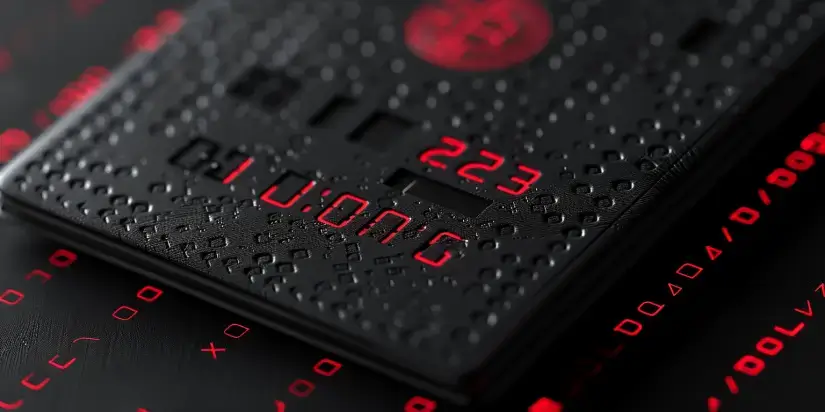
Why would someone want to receive Tether (USDT)?
Tether (USDT) is a stablecoin, which means it's designed to maintain a stable value by being pegged to a fiat currency, in this case, the US dollar.
This stability is a significant draw for users who want to avoid the volatility typical of other cryptocurrencies like Bitcoin or Ethereum.
Additionally, Tether operates across multiple networks, enhancing its adaptability and user accessibility.
Businesses find it helpful to convert USDT to other currencies via bank transfer for straightforward financial management.
Receiving payments in USDT offers a predictable value, making it an excellent choice for settling transactions without worrying about fluctuating market prices.
Moreover, USDT operates on multiple blockchain networks, including Ethereum and Binance Smart Chain, allowing fast and flexible transactions across diverse platforms.
For businesses and individuals engaged in international trade or services, receiving USDT simplifies payment without the high fees and slow processing times associated with traditional banking systems.
This accessibility and efficiency make USDT a preferred option for digital payments worldwide.
📚Read more: How to Send Tether (USDT) Between Wallets
How to receive Tether (USDT) from someone (Step-by-step)
Receiving Tether is a straightforward process, typically involving three key steps. Whether you're a beginner in cryptocurrency or looking for a refresher, these steps will guide you through receiving USDT securely.
Step 1: Set up a USDT-compatible wallet
Before you can receive USDT, you need a digital wallet that supports it. Choose a wallet that fits your needs, focusing on security features like two-factor authentication and backup options.
- Choose your wallet: Select from popular wallets that support USDT, such as swissmoney, Trust Wallet, or Ledger.
- Install the software: Download and install your chosen wallet application on your mobile device or computer.
- Secure your wallet: Set up a strong password, enable two-factor authentication, and make a secure backup of your wallet’s private keys. For enhanced security, consider using a hardware wallet, which stores your USDT offline and reduces the risk of hacks.
Step 2: Locate your USDT address
Your wallet address is a unique string of characters that functions like a bank account number. You will share it with the person sending you USDT.
- Access your wallet: Log into your wallet and find the section labelled ‘Receive’ or ‘Deposit’.
- Find your USDT address: Ensure you select USDT from the list of cryptocurrencies. Copy this address. This recipient's wallet address must be shared accurately to ensure the USDT arrives without issues.
- Verify the address: Double-check the address to make sure it is correct. Mistakes can result in lost funds.
Step 3: Share your USDT wallet address with the sender
Now that you have your address, you can share it with the person who needs to send you USDT. Ensure the sender knows how to send USDT correctly to avoid any delays or errors in the transaction. Always use a secure method when sharing your address.
- Communicate securely: Use a secure messaging platform or email to send your address to the sender. Avoid public forums or social media.
- Confirm the address with the sender: To avoid errors, have the sender confirm your USDT address before they send the funds. For convenience, you can generate a QR code of your USDT address and share it with the sender.
- Wait for the transaction: Monitor your wallet once the sender has sent the USDT. Transactions typically take a few minutes but vary depending on network traffic and blockchain conditions.
Following these steps will help ensure that you receive USDT safely and efficiently. Always prioritise security by double-checking addresses and using secure platforms for communication.
Looking for a crypto wallet to receive USDT crypto easily, quickly, and securely? Discover swissmoney
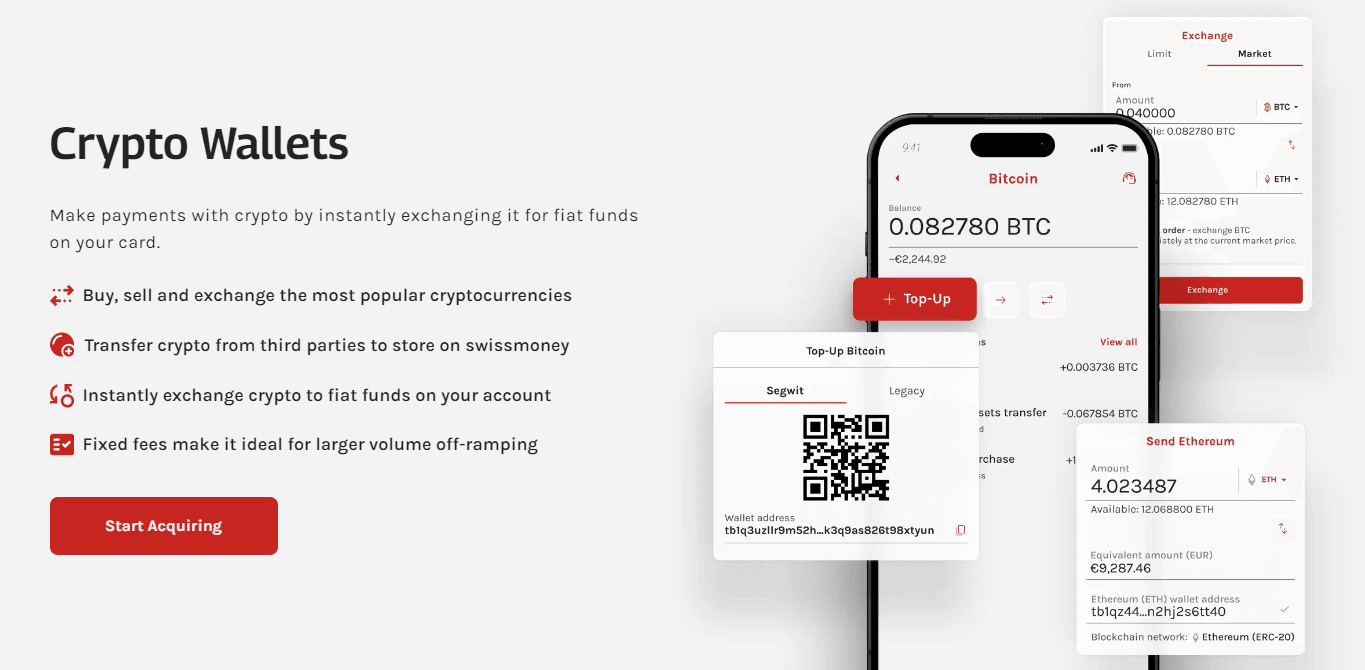
swissmoney offers a seamless and secure solution for handling your USDT transactions, whether receiving payments or managing your cryptocurrency portfolio.
With swissmoney, you can access a robust platform that simplifies your crypto transactions without compromising security.
- All-in-one solution for both crypto and fiat management (Wallet, Card & IBAN)
- User-friendly interface: swissmoney's platform is designed for ease of use, making it simple for beginners and experienced users to manage their crypto assets.
- Enhanced security measures: Protect your USDT with state-of-the-art protocols, including multi-factor authentication and cold storage options.
- Rapid transactions: Enjoy quick processing times, ensuring you can receive and use your USDT with minimal delay.
How to receive Tether (USDT) on swissmoney wallet
Receive USDT on your swissmoney wallet is designed to be straightforward and secure, catering to both novice users and seasoned crypto enthusiasts.
Here’s how you can start receiving USDT through swissmoney:
1. Log into your swissmoney account: Access your swissmoney wallet by signing into your account. If you don’t have an account, you must create one first.
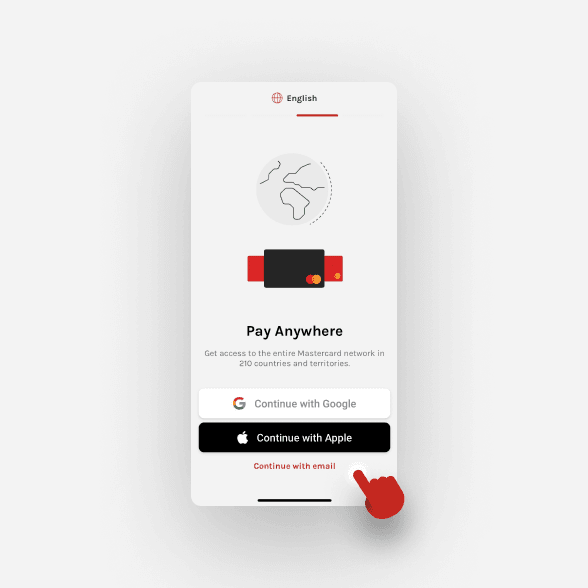
2. Navigate to the Digital Assets section and choose Tether Wallet from the list. If you don’t have a Tether wallet, create it by clicking ‘+Add new’.
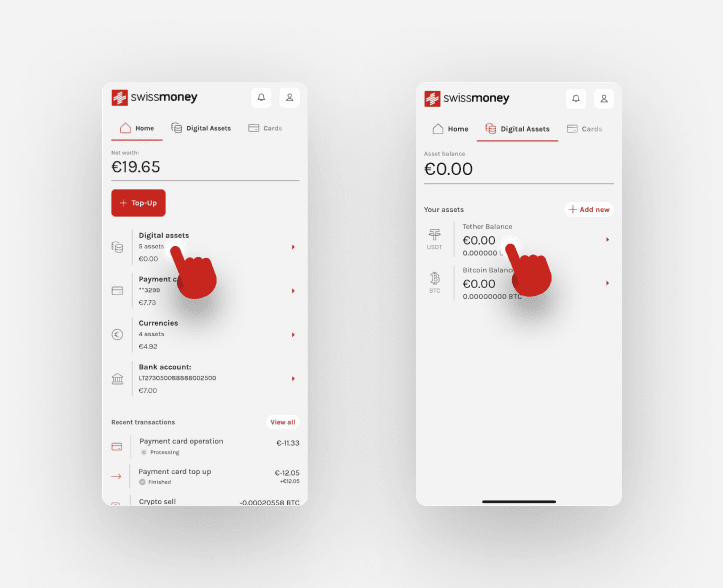
3. Open a USDT wallet and locate the 'Receive' or 'Top-up' option within the dashboard.
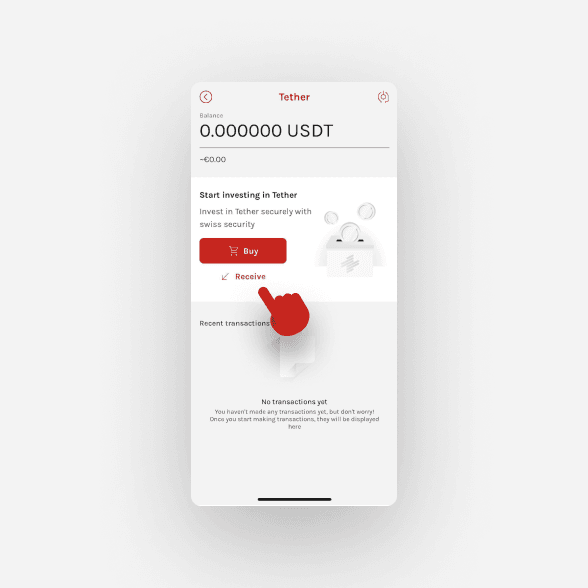
4. Copy a USDT wallet address: Your unique address will be displayed. This is the address you need to share with the sender. To simplify the process, swissmoney provides a QR code for your USDT address that can be scanned directly.
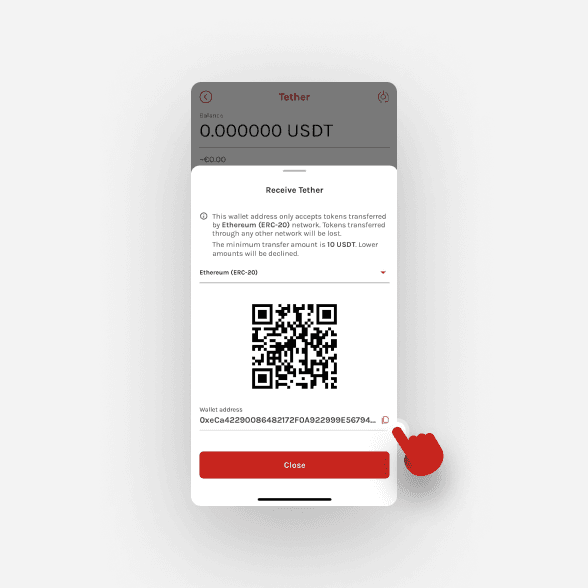
5. Share your address: Provide your address to the person or platform sending you Tether. You can do this securely via email or another secure method of communication.
6. Confirm the transaction: Once the sender has transferred USDT to your address, you should see the funds in your swissmoney wallet shortly, depending on network traffic.
By following these steps, you can easily and securely receive USDT in your swissmoney wallet, taking full advantage of swissmoney’s robust security and user-friendly interface.
Additionally, once USDT is received, swissmoney users can easily convert it to fiat and initiate a bank transfer directly from the platform.
📚Read more: How to Create a USDT TRC20 Wallet
How to receive Tether (USDT) on Trust Wallet

Receiving USDT in your Trust Wallet involves simple steps to transfer your funds securely. Follow this guide to start receiving Tether in Trust Wallet:
- Open Trust Wallet: Launch the Trust Wallet app on your device. Download Trust Wallet from the App Store or Google Play if you haven't installed it.
- Access your wallet: Open your wallet by logging in or creating a new wallet if you are a new user.
- Find USDT: Scroll through or search for Tether in your list of assets. If you haven’t added USDT to your list of cryptocurrencies, tap on the ‘+’ sign to add it.
- Tap on Receive: For Tether, tap the ‘Receive’ button to view your USDT address.
- Copy your address: Copy the USDT address displayed. Trust Wallet allows you to display a QR code for your USDT address, making it easy for senders to scan and send funds without error.
- Share your address: Send your copied USDT address to the sender securely, ensuring no errors in transcription.
- Check your wallet: You can review the transaction history in Trust Wallet to confirm that the USDT has been received. Once the blockchain has processed the transaction, the USDT should appear in your balance.
With these steps, you can easily receive USDT in your Trust Wallet, using its straightforward interface and strong security features to manage your cryptocurrency safely.
How to receive Tether (USDT) on Coinbase wallet
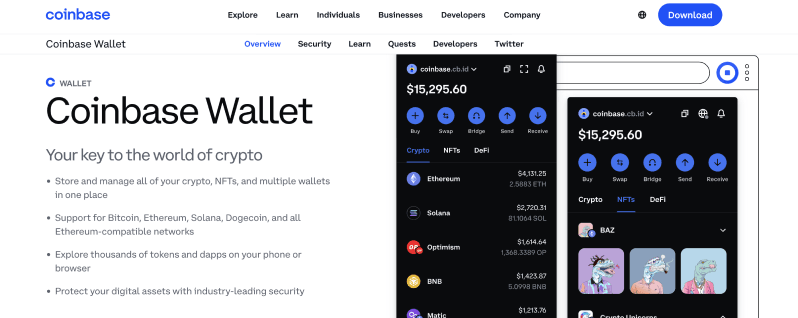
Receiving USDT on your Coinbase Wallet is a simple and secure process tailored for beginners and experienced cryptocurrency users. Follow these steps to receive Tether on Coinbase wallet:
- Open Coinbase Wallet: Launch the Coinbase Wallet app on your mobile device or access it via a web browser.
- Access your wallet: Log into your Coinbase wallet. You must set up a new wallet first if you're a new user.
- Select USDT: Navigate to the ‘Receive’ tab and search for USDT in the list of supported cryptocurrencies.
- Get your USDT address: The app will display your address. Make sure to copy this address carefully. Coinbase Wallet uses a QR code to receive USDT, ensuring accuracy when sharing your address.
- Share your address: Safely share your copied USDT address with the sender. You can send it via secure email, a messaging app, or another secure digital method.
- Confirm the transaction: Once the sender has completed the transfer, wait for the USDT to appear in your wallet. The arrival time may vary based on network conditions and transaction volume.
Using Coinbase wallet allows you to receive Tether confidently, utilizing its robust security measures and user-friendly interface.
How to receive Tether (USDT) on MetaMask wallet
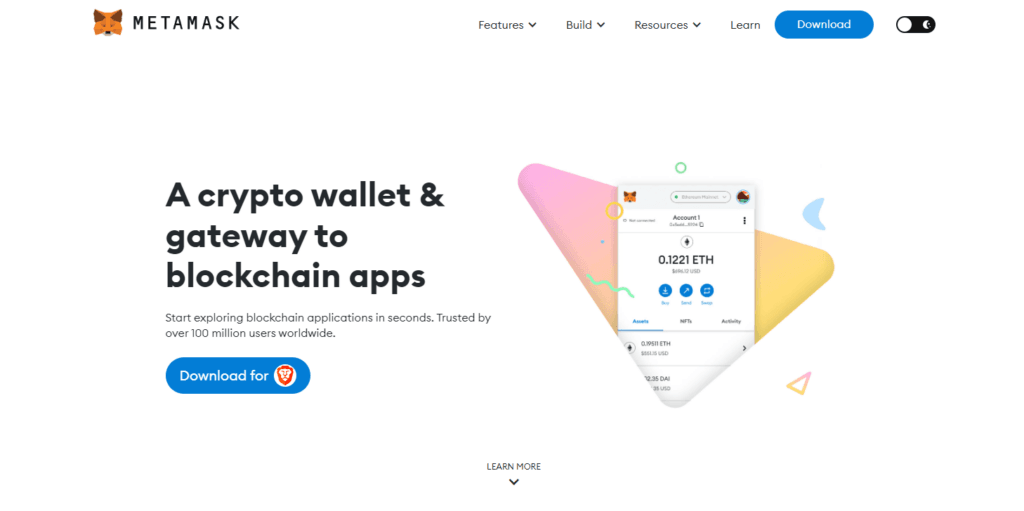
Receiving Tether (USDT) in your MetaMask wallet involves key steps to transfer your tokens safely. Here’s how to securely receive Tether using MetaMask:
- Open MetaMask: Launch the MetaMask extension in your web browser or open the MetaMask app on your mobile device.
- Access your wallet: If you haven’t already created a MetaMask wallet, follow the prompts to set one up. Otherwise, log in to your existing wallet.
- Add USDT to your wallet: MetaMask does not list all tokens by default. To add USDT, click ‘Add Token’, search for USDT, and confirm its addition to your wallet.
- Find your USDT address: Navigate to the main account page, where your Ethereum address is visible. This same address is used to receive Ethereum-based tokens like USDT.
- Copy your USDT address: Copy the Ethereum address from MetaMask. Ensure accuracy, as this will be the address used to receive Tether.
- Share your address with the sender: Provide your Ethereum address to the person or entity sending you USDT. Ensure the communication method is secure to prevent potential fraud.
- Check for incoming USDT: After the sender completes the transaction, monitor your MetaMask wallet. The USDT should appear once the transaction is confirmed on the blockchain.
These steps will help you receive Tether on MetaMask safely, leveraging its compatibility with Ethereum and ERC-20 tokens to manage your digital assets effectively.
What to consider before receiving Tether (USDT) from someone
Before you receive Tether from someone, it's essential to consider several factors to ensure a smooth and secure transaction. Here are key considerations:
- Wallet compatibility: Confirm that your wallet supports USDT, particularly the blockchain network it’s issued on (e.g., Ethereum for USDT-ERC20). Not all wallets support all versions of USDT.
- Sender's information: If possible, know the sender's reliability and reputation, especially in significant transactions. This reduces the risk of fraud.
- Transaction fees: Be aware of the fees associated with receiving Tether. These fees can vary depending on the blockchain network used for the transfer.
- Network congestion: Consider the current state of the network. High congestion on the blockchain can lead to slower transaction times and higher fees.
- Security measures: Ensure your wallet and associated accounts are secured with strong passwords, two-factor authentication, and other security features.
- Address accuracy: Double-check the wallet address you provide to the sender. Errors in this address can result in the irreversible loss of funds.
- Regulatory considerations: Be aware of any legal and tax implications that may apply to receiving and holding cryptocurrency in your jurisdiction.
Considering these factors, you can minimize risks and ensure you receive Tether (USDT) as securely and efficiently as possible.
📚Read more: How Much Does it Cost to Send Tether?

What are the most common security risks of receiving Tether (USDT)?
Like any cryptocurrency transaction, receiving USDT carries certain security risks. Being aware of these risks can help you take the necessary precautions to protect your assets:
- Address misrepresentation: One of the most common errors is miscommunication or mistyping an address. This can lead to funds being sent to the wrong address and lost permanently.
- Phishing attacks: Fraudulent parties may attempt to deceive you into revealing your private keys or wallet credentials via fake websites, emails, or messages.
- Hacking and malware: Hackers may target your computer or mobile device to steal credentials and access your cryptocurrency wallets. Installing malware is a common method used.
- Scams: Be cautious of scams promising returns or asking for USDT for verification purposes. Always verify the authenticity of requests to send or receive cryptocurrency.
- Exchange security: If you use an exchange wallet to receive Tether, you are relying on the exchange's security measures, which may be vulnerable to breaches.
- Smart contract vulnerabilities: For USDT sent via smart contracts (as on Ethereum), bugs in the contract code could potentially be exploited to steal funds.
- Network risks: Transactions on the blockchain are generally secure, but vulnerabilities or congestions on specific networks can affect transactions.
Understanding these risks and implementing strong security practices, like using a hardware wallet and enabling two-factor authentication, can help safeguard your USDT assets against common threats.
📚Read more: How to Stay Safe from Bitcoin Scams And Frauds
Conclusion: How to receive USDT
Receiving Tether can be straightforward when equipped with the right information and tools. By ensuring that your wallet is secure, compatible, and correctly set up, you can safely receive Tether (USDT) from anyone worldwide.
Always stay vigilant about security risks and take proactive steps to safeguard your digital assets.
Whether you're using Tether for personal transactions, business dealings, or investment purposes, understanding the underlying processes and precautions will help you navigate the crypto world more confidently.
Using the steps outlined in this guide gives you complete control over receiving USDT, ensuring security and efficiency.
FAQs
Can you receive Tether (USDT) from anyone?
You can receive Tether from anyone with it in their digital wallet, provided they have your address.
How can I receive USDT from someone?
To receive Tether, you must provide the sender with your wallet address supporting USDT. Ensure your wallet is set to the correct network that corresponds with the USDT version being sent.
How much Tether (USDT) can I receive?
There is no technical limit to how much USDT you can receive. However, individual wallets or platforms may impose transaction or balance limits.
Are there any limitations to receiving Tether (USDT)?
Limitations may depend on the wallet or network capacity, especially during high congestion. Some wallets might also have transaction limits or require additional verification for large amounts.
How long does it take to receive Tether (USDT) from someone?
The transaction time can vary based on the blockchain network used. For example, USDT transactions on the Ethereum network might take longer during high network traffic.
What are the fees associated with receiving Tether (USDT)?
Transaction fees for receiving Tether depend on the blockchain used for the transaction and current network congestion. The sender usually pays these fees.
How can I receive USDT TRC 20 without fees?
To receive USDT TRC 20 without fees, both sender and receiver must use a wallet and platform that supports fee-free TRC 20 transactions, such as certain exchanges offering internal off-chain transactions.
What are the tax implications of receiving Tether (USDT)?
The tax implications of receiving Tether vary by country. Generally, receiving USDT as a payment or gift could be taxable. Consult a tax professional in your jurisdiction for detailed advice.
What is the best wallet to receive Tether (USDT)?
The best wallet to receive Tether depends on your needs for security, usability, and support for different blockchain networks. Popular choices include swissmoney, MetaMask, Trust Wallet, and Ledger for hardware wallet security.
📚Read more: Best Tether (USDT) Wallets
How do I know which network my wallet uses for Tether?
Check your wallet’s documentation or settings. Most wallets will specify which blockchain networks they support for USDT (e.g., Ethereum for ERC-20, TRON for TRC-20).
Is it possible to receive Tether (USDT) anonymously?
Receiving Tether anonymously is challenging as most transactions are recorded on a public blockchain ledger. However, anonymity can be increased by using privacy-focused wallets and not sharing your wallet details publicly.

